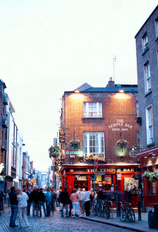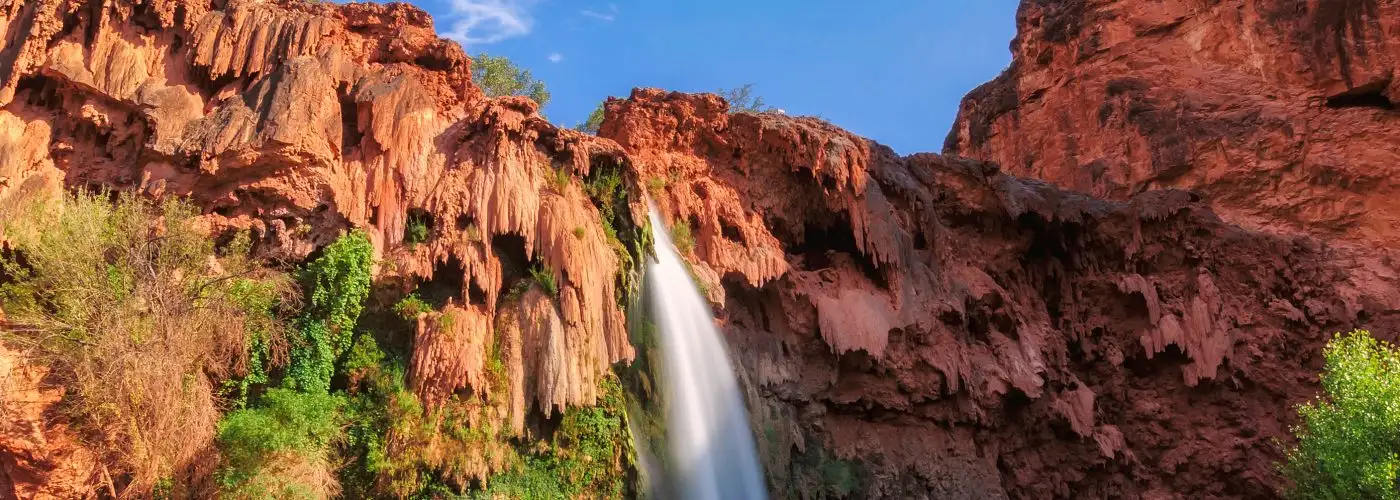“Is that the trailhead?” I ask skeptically as I peer into the enormous white cloud that’s swallowing the canyon below me. I’m preparing to hike to Havasu Falls, but right now the lack of an obvious trail has me doubting the directions on my map.
Soon a hiker emerges from the mist and greets me with a weary smile, dropping his heavy pack onto the reddish-brown dirt of Hualapai Hilltop. “Once you get going, the trail’s pretty obvious,” he says. Then, almost as an afterthought, he adds, “But watch your step on the switchbacks or you’ll fall off the cliff.”
With that helpful advice in mind, I strap on my backpack, tighten the laces of my hiking boots, and begin my own descent toward one of the Arizona’s most remote treasures: the legendary blue-green waters of Havasu Falls.
https://www.instagram.com/p/4E6AHXJAFJ/?taken-by=jauntist
Hiking to Havasu Falls
The 10-mile hike into Havasu Canyon that starts at Hualapai Hilltop is by far the cheapest way for budget travelers to reach the falls (there’s just a small entrance fee, waived for children seven and under). But it’s not the only possibility. The local Havasupai tribe also offers guided horseback trips, luggage transfers by packhorse, and helicopter rides to the canyon floor.
After a dozen switchbacks, the path flattens out and follows red sandstone cliffs into the Indian village of Supai, eight miles from the Hualapai Hilltop trailhead. The hike down isn’t especially hard, and pack horses and mules pass by several times each day, so there’s little chance of losing your way.
It’s important to be prepared for the heat, though. The Arizona sun, sweltering in summer and only slightly less withering in the off-season, can sap the strength of even the most seasoned hikers. It’s essential to drink plenty of water or risk dehydration or heatstroke.
Supai village, framed on three sides by the towering canyon walls and watched over by the precariously balanced Wigleeva rock formation that local legend hails as a tribal protector, is one of two overnight options for travelers en route to Havasu Falls. I chose to spend the night at the tribal-run Havasu Lodge in the village (the other option is the campground two miles further on the trail, also run by the tribe). Supai is also home to a small grocery store, cafe, school, helicopter landing pad, and stables.
https://www.instagram.com/p/4JbILbpANl/?taken-by=jauntist
Hiking to Havasu Falls and Mooney Falls
The first of Supai’s famous waterfalls is just a half hour’s walk from the village outskirts, and the most spectacular of them—Havasu Falls—announces with a loud roar long before you see it.
At Havasu Falls, luminous green-blue water cascades into a natural amphitheatre carved out of the red cliffs. Dozens of tiny pools and secondary falls spill out of the larger pool, each of them capped by sparkling crowns of tiny white waves. After a hike in the sunny canyon, where shade can be hard to come by, the falls give off a welcome cooling mist—and on summer days the pools are often full of swimmers evading the blistering heat.
Another mile down the trail is Mooney Falls, named after a drunken cowboy who fell to his death there, and punctuated in places by warning signs that say things like “use extreme caution” and “proceed at your own risk.” To get to the bottom of Mooney Falls, you have to navigate a bewildering hive of narrow caves, wet rocks, slippery ladders, iron handholds, and rusted chains, all carved into and out of the 200-foot high sandstone cliffs. It’s like nature’s version of an American Ninja Warrior obstacle course.
Mooney Falls can be viewed and enjoyed safely from above, where the trail loops around to offer ideal vantage points for photographers. But the warren of caves and ladders is the only route for those wishing to continue following the falls deeper into the canyon. Especially daring adventurers might attempt to navigate the numerous dead ends and false trails from here, but there is the return hike to consider as well. Depending on the time of day, you might want to save your energy for the climb back to the lodge or campground.
https://www.instagram.com/p/4G78DhpALl/?taken-by=jauntist
When to Visit Havasu Falls
The best time to visit Havasu Falls is early spring or late fall when the crowds are thinner, the scenery is splendid, and the heat is manageable.
While the majority of travelers visit in the summer months, temperatures can rise to well over 100 degrees inside the canyon, and conditions can quickly become dangerous for the unprepared. Havasu Falls is accessible year-round, and each season provides a different backdrop for your experience.
If you’re traveling from outside the Southwest, look for flights into either Phoenix or Las Vegas. A rental car is also a must from either airport. Expect to drive at least four hours to reach the trailhead. You’ll want to get an early start on your journey into the canyon to avoid the afternoon heat, which likely means spending the night at either the Hualapai Lodge near the (very loud) train tracks in Peach Springs, or the kitschy (and cheaper) Grand Canyon Caverns Inn on Route 66. Both are about an hour’s drive from Hualapai Hilltop, but only the Caverns Inn features a gigantic replica T-Rex on its front lawn.
Planning a Trip to Havasu Falls
Visiting Havasu Falls can be done in several ways. For the budget-conscious and physically fit, the most cost-effective route is to hike into the canyon and carry all of your gear with you. Once you arrive in Supai, you can either indulge in the wonders of indoor plumbing at the 24-room Havasupai Lodge or set up your tent at the campground two miles further along.
The three- to four-hour guided horseback ride into the canyon departs from Hualapai Hilltop between 10:00 a.m. and noon. If you choose to hike in but don’t relish the prospect of the return trip on foot, one-way rides out of the canyon can be arranged as late as a day in advance of your departure from the lodge or campground.
Havasu Canyon is also serviced by Airwest Helicopters of Arizona, which arranges flights into and out of Supai twice per week during the off-season and up to four days per week during the busier months of April through October.
From Supai, it’s an easy hike to Havasu Falls and back. Guided horseback tours are also available for lodge guests (reservations must be made at least one day in advance). If you hiked into the canyon, however, there’s little need to take the guided daytrip to the falls. You can handle the waterfall hike.
Images of Havasu Falls appear everywhere in Grand Canyon National Park, from postcards to tour books to wall calendars. And yet, remarkably, only a tiny percentage of park visitors ever see the emerald green waters in person. But with proper planning almost anyone can do it—regardless of fitness level or budget.
More from SmarterTravel:
- Hoofing it Down Grand Canyon’s North Rim
- Grand Canyon: Secrets of the South Rim and Phantom Ranch
- 10 Natural Wonders Near the Grand Canyon
Editor’s note: This story was originally published on August 6, 2008. It has been updated to reflect the most current information about hiking to Havasu Falls and Mooney Falls.
We hand-pick everything we recommend and select items through testing and reviews. Some products are sent to us free of charge with no incentive to offer a favorable review. We offer our unbiased opinions and do not accept compensation to review products. All items are in stock and prices are accurate at the time of publication. If you buy something through our links, we may earn a commission.
Related
Top Fares From
Today's Top Travel Deals
Brought to you by ShermansTravel
Greece: 9-Night Vacation, Incl. Meteora &...
Exoticca
 vacation
$2149+
vacation
$2149+
London to Reykjavik: Luxe, 10-Night Northern...
Regent Seven Seas Cruises
 cruise
$8175+
cruise
$8175+
Ohio: Daily Car Rentals from Cincinnati
85OFF.com
 Car Rental
$19+
Car Rental
$19+




